Traditional shifting cultivation (jhum) practiced in the undulated topography of the Lusei hills often results in loss of soil fertility, disruption of ecosystem services, degradation of natural resources and lower crop productivity. Shifting cultivation is the backbone of rural economy and farmers’ livelihood in Mizoram, as an indispensable part of cultural Mizo ethnicity. The jhum agro-ecosystem evolved as the maximum degree of crop diversification, dominated mostly by traditional long duration, low yielder crop cultivars. Moreover, increasing population pressure brought down the jhum cycle from 25 years to 5-6 years. Integrated Farming System (IFS) is the potential alternative for the Mizo farmers in order to enhance ecosystem service and reduction in natural resource degradation. ICAR Research Complex for NEH Region, Mizoram center, Kolasib established model rice based IFS under contrasting land form at Kolasib district, Mizoram under Tribal Sub Plan (TSP). The contrasting landforms belong to Mr. Lalsangkhima (24020’22” N, 92041’03” E) and Mrs. Lalhmingmawii (24001’26” N, 92040’32” E); both of them were adapted for technology demonstration on rice based IFS for the farmers at Kolasib district with proper supervision from the ICAR Research Complex for NEH Region, Mizoram Centre (Kolasib). The livestock components were indispensable part of both IFS models. The component wise allocation details are presented in table1.
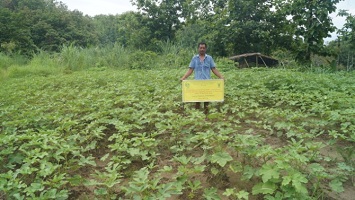

Table 1: Components of Integrated Farming System models with component wise area allocations
| Farmer name | Location | Seasonal crop sequence (area allocations in ha) | Animal component (ha) | Plantation crops/ Agroforestry systems (ha) | Fish component (ha) | Farm waste recycling (ha) | ||
|---|---|---|---|---|---|---|---|---|
| Summer | Kharif | Winter | ||||||
| Mr. Lalsangkhima | Phaipheng, Kolasib district (mixed hill land scape dominated by flatland; Land capability Class III) | Okra –Arka Anamika (3.2 ha) | Gomati paddy (4.2 ha) | Brinjal–Pusa Anupam and Cabbage – Rare Ball, leafy mustard – Pusa Saag 1, Broccoli – KTS 1 (1.8ha) | Six cross bred pigs (5 female 1 male) and sixty Vanaraja poultry birds (0.10 ha)
|
Oilpalm integrated with RCT-1 turmeric (3.41 ha) | Common carp and grass carp
(1.2 ha) |
Aerobic composting(0.012 ha)
|
| Mrs. Lalhmingmawii | Kawnpui, Kolasib district (steep hill land scape; Land capability Class IV) | Sweet corn (1.8 ha) | Gomati paddy (3.5 ha) | Zero till cultivation of leafy mustard- Pusa Saag 1, Sweet corn + frenchbean - contender (1.2 ha) | Six HF cows (5 female 1 male) and fifty Vanaraja poultry birds (0.60 ha)
|
3.60 (arechanut and banana plantation) | Common carp and grass
(2.1 ha) |
Aerobic composting(0.010 ha)
Vermicomposting-(0.01 ha)
|
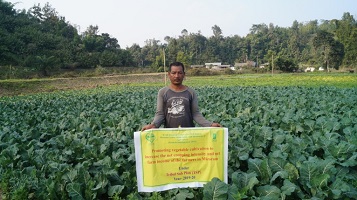
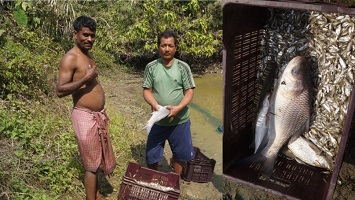
Rainfed jhum farming with subsistent small scale kitchen gardening on vegetables during winter months was predominant practice for both the farmers till 2016. Fingerlings of Common carp, grass carp were provided periodically from 2016-17 to 2020-21. Irrigation infrastructure were developed with HDPE pipe networking, renovation of ponds and excavation of jalkund (20000 L). Native grass species viz. broom grass, congo signal, hybrid napier and guinea grass were used for slop stabilization, restriction of soil erosion and to ensure the year around fodder supply. With the establishment of model IFS, system based rice equivalent yield increased for Mr. Lalsangkhima (424.4 t ha-1 against 59.9 t ha-1, as initial) and Mrs. Lalhmingmawii (435.7 t ha-1 against 77.8 t ha-1, as initial). Most of the inputs/byproducts were recycled through either aerobic composting or vermicomposting (combined contribution 25.98%), with integrated use of supplementary chemical fertilizers (N, P2O5 and K2O; 74.02%). The animal rearing component was mostly relied on traditional on-farm availability of fodder and kitchen wastes with need based use of mineral mixture and other feed supplements. After five years of ICAR-NEH Mizoram center intervention, cumulative benefit cost ratio (B: C ratio) was increased from 0.93 to 3.20 for Mr. Lalsangkhima (Employment generation: 304 to 3404 man days) and 1.22 to 3.65 for Mrs. Lalhmingmawii (Employment generation: 450 to 3600 man days). Inclusion of diversified animal components (pig, cow, poultry and fishery) resulted in the sharp rise in farmers’ income over the period of our study (2017-2021). In courtesy, Cumulative Land Utilization Index (CLUI) was hiked by ~1.4 times for both of them with large scale adaptation of high yielding short duration agricultural and horticultural crop varieties with more areas under irrigated intensified cropping systems (Table 2).
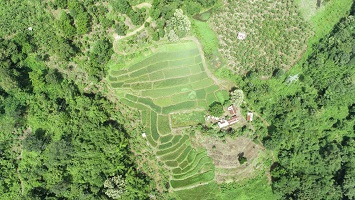
Table 2: Farm economics of integrated farming systems for selected farmers in Kolasib, Mizoram
| Parameters | Mr. Lalsangkhima | Mrs. Lalhmingmawii | ||
|---|---|---|---|---|
| BI | AI | BI | AI | |
| Rice equivalent yield (t ha-1) | 59.9 | 424.4 | 77.8 | 435.7 |
| Cost of production/ cultivation (Rs. thousand ha-1) | 124.24 | 404.26 | 140.24 | 374.98 |
| Net returns (Rs. thousand ha-1) | 115.36 | 1293.34 | 171.08 | 1367.92 |
| B:C ratio | 0.93 | 3.20 | 1.22 | 3.65 |
| Employment generation (man days) | 304 | 3404 | 450 | 3600 |
| CLUI (%) | 38.51 | 94.5 | 41.02 | 98.7 |
| Input saving percentages (%) | - | 61.03 | - | 69.0 |

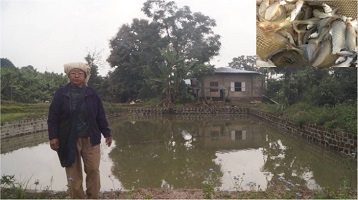
Note:
- BI: Before Intervention (mixed cultivation under shifting agriculture as reference, expressed in terms of rice equivalent yield).
- AI- After Intervention. (Averaged over 2017-2021 annual farm income)
Impact: Mrs. Lalhmingmawii completely shifted from practicing rainfed jhum cultivation to settle cultivation into arechanut and banana orchard establishment in steep hilly landform with irrigated farming after land development (terracing). Initially, there were very limited scopes for cultivation. With the intervention of ICAR RC NEHR Mizoram center under TSP project, her irrigation water supply channels were built up for applying supplemental irrigation in orchards during non-rainy months and additional scope on winter vegetable cultivation. Before 2016-17, she practiced rainfedwet land rice culture (170-180 days) followed by local leafy vegetable system (after rice residue burning at subsistent level; duration-30 days) during mid-May to early December. After TSP programme implementation, the long duration traditional rice varieties were replaced by Gomati (duration 130 days; June-mid October). Unlike previous years, the left over fallow period after wetland rice culture were utilized for commercial winter vegetable cultivation (November to February), followed by hybrid sweet corn culture in summer months (mid-March-May) under TSP. In courtesy, Mr. Lalsangkhima practiced long duration local wetland rice (duration 170-180 days) followed by winter fallow before 2016-17 in flat land configuration. Under Tribal Sub Plan, ICAR-NEH demonstrated vegetable cultivation during winter (crucifers and tomato/brinjal) and summer (cowpea/ okra) months. Thus, 300% cropping intensity were achieved for both the circumstances. Moreover, introduction of improved animal breeds like the Hampshire crossbred pig and Vanrajapoultry rearing in rural backyards secured higher profitability for both the established IFS model. Gradually both of them became model farmers in their respective villages after ICAR NEH Mizoram center interventions with contrasting landform at Kolasib district, Mizoram. Supportive capacity building programme were also organized to sensitize the other neighboring villagers for further replication of the tested IFS models. Hence, the positive impact of resource recycling in hilly agro-ecosystems through IFS system establishment benefited the Lusei tribes of Mizoram.








Like on Facebook
Subscribe on Youtube
Follow on X X
Like on instagram